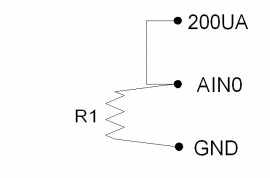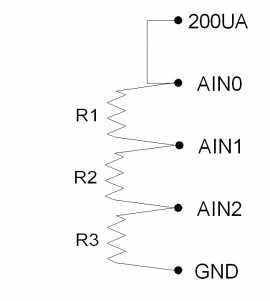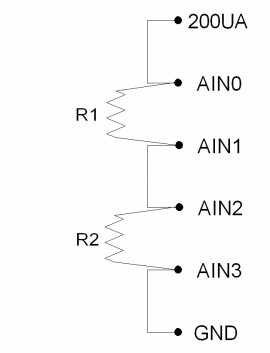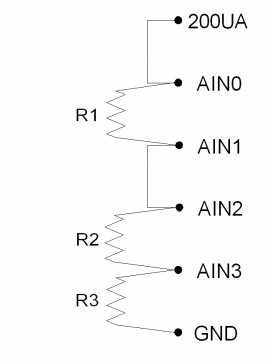2.5 - 10UA and 200UA [U6 Datasheet]
The U6 has 2 fixed current source terminals useful for measuring resistance (thermistors, RTDs, resistors). The 10UA terminal provides about 10 µA and the 200UA terminal provides about 200 µA.
The actual value of each current source is noted during factory calibration and stored with the calibration constants on the device. These can be viewed using the test panel in LJControlPanel, or read programmatically. Note that these are fixed constants stored during calibration, not some sort of current readings.
The current sources have good accuracy and tempco, but for improvement a
fixed resistor can be used as one of the resistors in the figures below. The Y1453-100 and Y1453-1.0K from Digikey have excellent accuracy and very low tempco. By measuring the voltage across one of
these you can calculate the actual current at any time.
The current sources can drive about 3 volts max, thus limiting the maximum load resistance to about 300 kΩ (10UA) and 15 kΩ (200UA).
Multiple resistances can be measured by putting them in series and measuring the voltage across each. Some applications might need to use differential inputs to measure the voltage across each resistor, but for many applications it works just as well to measure the single-ended voltage at the top of each resistor and subtract in software.

Figure 2.5-1

Figure 2.5-2
Figure 2.5-1 shows a simple setup measuring 1 resistor. If R1=3k, the voltage at AIN0 will be 0.6 volts.
Figure 2.5-2 shows a setup to measure 3 resistors using single-ended analog inputs. If R1=R2=R3=3k, the voltages at AIN0/AIN1/AIN2 will be 1.8/1.2/0.6 volts. That means AIN0 and AIN1 would be measured with the +/-10 volt range, while AIN2 could be measured with the +/-1 volt range. This points out a potential advantage to differential measurements, as the differential voltage across R1 and R2 could be measured with the +/-1 volt range, providing better resolution.

Figure 2.5-3

Figure 2.5-4
Figure 2.5-3 shows a setup to measure 2 resistors using differential analog inputs. AIN3 is wasted in this case, as it is connected to ground, so a differential measurement of AIN2-AIN3 is the same as a single-ended measurement of AIN2. That leads to Figure 2.5-4, which shows R1 and R2 measured differentially and R3 measured single-ended.
Figures 2.5-5 and 2.5-6 show the typical current source output variation over temperature. Both Current sources have very low temperature coefficients at or near 25C. Beyond 25C, the temperature coefficient variation may need to be accounted for, depending on application requirements.
Figure 2.5-5. Typical temperature coefficient values over operating temperature range . |
Figure 2.5-6. Typical current source deviation from 25C output over operating temperature range [1]. |
